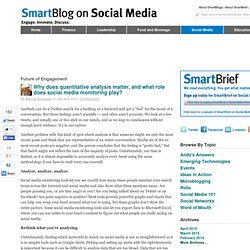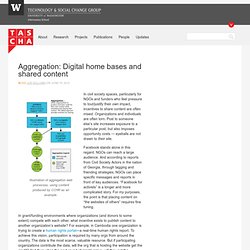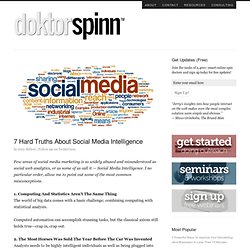

Understanding and Evaluating Big Data Text Analytics Solutions. Advanced Social Analytics & the Bottom Line – Nick Cifuentes, Ancestry.com. Web Analytics » The Top 13 Tools Tor Social Media Analysts. Text analytics, text understanding. Why does quantitative analysis matter, and what role does social media monitoring play? Anybody can do a Twitter search for a hashtag or a keyword and get a “feel” for the mood of a conversation.

But these feelings aren’t scientific — and often aren’t accurate. We look at a few tweets, and usually one or two stick in our minds, and so we leap to conclusions without enough hard evidence. It’s in our nature. Another problem with this kind of spot-check analysis is that someone might see only the most recent posts and think they are representative of an entire conversation. Maybe six of the 10 most recent posts are negative, and the person concludes that the feeling is “pretty bad,” but that batch might not reflect the tone of the majority of posts. Analyze, analyze, analyze. Aggregation: Digital home bases and shared content. Illustration of aggregation web processes, using content produced by CCHR as an example.

In civil society spaces, particularly for NGOs and funders who feel pressure to tout/justify their own impact, incentives to share content are often mixed. Organizations and individuals are often torn. Post to someone else’s site increases exposure to a particular post, but also imposes opportunity costs — eyeballs are not drawn to their site. Facebook stands alone in this regard. NGOs can reach a large audience. In grant/funding environments where organizations (and donors to some extent) compete with each other, what incentive exists to publish content to another organization’s website? At TASCHA, we have been wrestling with related issues and are refining a coping strategy: aggregation. The image outlines the strategy.
The Truth About Social Media Intelligence. Few areas of social media marketing is so widely abused and misunderstood as social web analytics, or as some of us call it — Social Media Intelligence.

I no particular order, allow me to point out some of the most common misconceptions. 1. Computing And Statistics Aren’t The Same Thing The world of big data comes with a basic challenge; combining computing with statistical analysis. Computed automation can accomplish stunning tasks, but the classical axiom still holds true—crap in, crap out. 2. Analysts needs to be highly intelligent individuals as well as being plugged into their industry at all times. B2B Social Media Best Practices for the Integrated Age. I’m pleased to introduce Rajesh Kadam, founder and CEO of Growth Fusion, as a guest blogger.

Growth Fusion is a boutique integrated marketing agency with a strong focus on ROI-driven Customer Acquisition and Demand Generation. Rajesh is a Marketo expert and has hands-on experience defining projects and implementing them at both venture-backed start-ups and consulting firms. We are very excited to welcome him. Social Media has quickly switched from a way for individuals to keep in touch, to a key strategy of business success.
For many companies, social media marketing is one of the key ways to attract, retain and interact with consumers. The value of social media as part of the B2B marketing mix includes branding, messaging, lead generation, and customer interaction. Marketo’s recent acquisition of Crowd Factory is a good example of how the sophistication of automated B2B marketing campaigns will continue to increase the impact of social media. 1. 2. 3. 4. Social CRM and how it could help your business... B2B Marketing Trends: A First Glimpse into Content Curation Habits and Activity. By Pawan Deshpande, CEO, HiveFire Last year my company, HiveFire Inc., shared the results from our B2B Marketing Trends survey and found that 82 percent of marketers are incorporating content curation – the process of finding, organizing, and sharing online content – as part of their overall content marketing strategy.

(Click through to this recent post titled “Content May Be King” for more content curation definitions and trends.) The fact that this represents a notable increase (up from 48 percent) from the Content Curation Adoption survey that we issued earlier that year sent a strong message that curation is gaining favor amongst marketers. Although we’d established that a large group of marketers were utilizing content curation as a tactic, there hasn’t been a study issued that has attempted to understand how, and why, those efforts are paying off.
Original Content vs. Capturing Reader Attention Posting Frequency Another key factor in driving engagement was posting frequency. 5 B2B Social Media Data Visualizations. One of the things I suggested in my 2011 predictions was that companies would find new ways to visualize data beyond spreadsheets and simple pie charts.

Interesting visuals tell a much more compelling story than flat numbers. This doesn’t mean you need to create fully blown data visualizations for every report, but think about visual ways to present your metrics for yearly reports or major presentations. A well-executed infographic is more fun to talk over than a list of numbers any day. Below are five infographics for inspiration. Tracking The Global Audience of Social Media B2B. Every so often we look at our global B2B audience and see where our posts resonate around the world.
While we understand that our audience is mainly in the US, we do have a growing following in other countries. It is worth looking at to determine things like relevant content, targeted advertising, time of day to publish posts and tweets, and even speaking opportunities. This is also information that is interesting to our publisher as they pursue foreign rights for The B2B Social Media Book. I looked at two different sources to determine our global audience, and I was surprised how much they correlate.
First I pulled Google Analytics from the past three months and looked at the top 10 countries of the site visitors. When looking at the list itself, the United States is first, followed by the UK and Canada. Social Business Analytics.
Pitney Bowes Business Insight Europe. Unternehmen in Zeiten der Experience Economy. Im letzten Jahr habe ich mich sehr viel damit beschäftigt, welche Auswirkungen das Web 2.0 auf Organisationen und Unternehmen hat.

Dabei ging es stets um das Unvermeidbare: Das Netz ist „sozial“ geworden – das bedeutet wir befinden uns in der Customer Experience Economy: Unternehmen verlieren die Kontrolle über Kommunikation, weil nun überall und von jedem über seine Customer Experience mit einem Produkt oder einen Arbeitgeber gesprochen werden kannJeder kann über alles mitreden und dabei auch den Zeitpunkt bestimmen (Sonntags, wenn die PR-Abteilung im Wochenende ist)Arbeitgeber werden bei kununu bewertet und niemand kann es verbietenMarketingbotschaften, die gelackt und stromlinienförmig ausgesendet werden, werden nicht gehört oder im Web 2.0 seziertIntransparentes oder unkorrektes Verhalten verschwindet nicht mehr „einfach so“ von der Tagesordnung (Guttenberg / Wulff)Fassaden werden eingerissen und das, was übrig bleibt, wird offensichtlich.
Das Internet ist sozial geworden. Wie man mit der Experience Economy gewinnt. Wie Content die Customer Experience verbessert und damit den e-Commerce ankurbelt. Die Möglichkeiten von Online-Kunden sind heute größer als je zuvor: Sie kommunizieren mit und über Unternehmen über eine Vielzahl an verschiedenen Kanälen und profitieren gleichzeitig von einer besseren Preistransparenz, einem umfangreicheren Informationsangebot sowie personalisiertem Content in sozialen Netzwerken.

Das Online-Angebot war dabei nie größer und der Wechsel von einem Shop zum nächsten nie einfacher.